Power steering fluid is an essential part of your auto steering system. It allows you to drive or turn a car with ease. You need to know how long does power steering fluid lasts in order to maintain the optimal performance of your vehicle.
Because it ensures that the hoses, pistons, valves, and servo pumps work optimally. You need to keep an eye on the quality of your vehicle’s power steering fluid and flush and replace it when necessary.
Otherwise, the power steering pump will start to deteriorate. Also, power steering oil reduces the energy required to turn the wheels. Many people only change their power steering fluid when they run into difficulties.
Therefore, you may be confused as to whether the power steering fluid can go bad or drain. And what happens when the power steering fluid goes bad?
Don’t worry, in this article, we will see how power steering oil lasts, how power steering oil can go bad, and what the consequences are when it ages.
Does Power Steering Fluid Go Bad?
The short and small answer is yes. Power steering fluid deteriorates over time. The longer power steering is used on a vehicle, the worse this condition becomes.
Because of this, many mechanics are aware of the problem and can fix it quickly when spotted during routine service visits. Leaking fluid can burn components in the rack and pinion system that transmits power from the engine to the wheels.
So he kept it at the right level and changed it according to the manufacturer’s specs so this fluid wouldn’t go bad or become obsolete.
How Long Should Power Steering Fluid Last?
Power steering fluid is one of the most important hydraulic fluids for your vehicle. This fluid is used to reduce wear and tear in the moving parts of the steering system. Also, power steering oil reduces the energy required to turn the wheels.
Many people only change their power steering fluid when they run into difficulties. Its useful life depends on the vehicle, its use, the type of power steering, and the composition of the fluid. Whether open or not.
Suggestion: Engine Knock On Startup Then Goes Away – 6 Top Causes And Solutions
If you open your power steering fluid and store it properly, it will last 2-3 years. Power steering fluid life generally depends on storage and sealing. Also, if not opened, you can expect your power steering fluid to last 3-4 years.
Sometimes power steering fluid doesn’t last a year if it’s not properly sealed. Because the liquid is heavily contaminated or collapsed for some reason.
Top Signs That Power Steering Fluid Is Going Bad
You can see a number of symptoms when the power steering fluid level in the reservoir is low. If you are having any of the following problems with your car’s power steering you should have your power steering fluid checked, it could just be low! It’s also easy to top up the power steering oil.
– Squealing Noise Generate

A howling or screeching sound, when the wheels turn, can be an indication that the power steering fluid is low. The power steering fluid is available online or at auto supply stores and is easily replaced, but a drop in fluid volume can indicate a power steering rack leak.
Replacing the power steering fluid will only temporarily solve the problem unless the leak is repaired.
– Difficult to Handle Steering Wheel

The more fluid you lose from your power steering, the more difficult it becomes to turn the steering wheel. It will continue to get more difficult as the system continues to lose fluid.
Also Check:
If enough fluid is lost, the power steering pump can burn out, and replacing the pump is not cheap. But if you lose your power steering entirely, first make sure it’s not a bad connection or fuse before you go out and buy a new pump.
– Fluid leaks

Power steering pumps also have seals that can develop leaks which then create a low fluid level. If you suspect a faulty power steering pump, you should check for leaks.
Low-performance power steering fluid can damage the pump and cause it to make unusual noises. You can prevent further problems by detecting a leak early.
Symptoms of power steering fluid leaks include red or tan puddles forming under your car. This is the easiest way to find out if your power steering pump is leaking fluid.
– Wheel Starts to Jerk

Does your power steering start to wobble or shake in your hands while driving? This could be due to a low power steering fluid level.
Another sign of power steering failure is when your car shakes badly at idle. Be sure to have it checked by a professional mechanic. They will be able to tell you if this is the reason for the tremors.
How Often Should You Change the Power Steering Fluid?
The answer to this question is more complicated than simple gasoline or oil. Some experts will tell you to change it every 75,000 to 100,000 miles, while others simply say it should be changed every two years.
Popular For You: 9 Amazing Long Distance Driving Tips For a Safe And Enjoyable Trip
The reality is that there is no truly definitive answer, and even automakers disagree. The best advice one could give would be to find yourself somewhere in the middle. Whether it’s every two years or every 75,000 miles ( Which comes early), you should change your power steering fluid.
How To Check & Fill Up Power Steering Fluid?
Power steering might seem like a luxury you could do without, but if you have it and it fails you could be putting yourself in danger.
Typically, a power steering fluid leak can be the cause of the failure. Luckily, it’s easy to check the fluid whether the car is hot or cold. And top up when the power steering fluid is low.
1. Warm Up the Fluid
To get a proper analysis of your power steering fluid, you should first warm it up. To do this, simply start your engine and let it idle until the temperature gauge reaches a normal level. Then turn the steering wheel in one direction until it clicks into place.
2. Locate Your Reservoir
Once warm, turn off the engine and open the hood. The power steering fluid reservoir is located under the hood. It is usually located on the passenger side of the vehicle where the belts are located on a smaller or transverse engine.
Also Check:
But sometimes the reservoir is located on the driver’s side as well. Either way, the word “Address” will likely be engraved at the top.
3. Check the Fluid Level
You will find two main things to check when it comes to your power steering fluid. First, you need to check the level. Whether you can see through your tank or need to pull out a dipstick, you should be able to see the MIN and MAX lines.
Don’t Miss To Checkout: Why Are My Brake Lights Staying On When Car is Off?
If you see a MIN line, your steering system needs fluid to do its job. However, if the fluid level is between these lines, you do not need to add more. If it is below the minimum, you must add more liquid. Be careful not to cross the MAX line.
4. Check the Quality of the Power Steering Fluid
The second thing to check is the quality of the liquid. All you have to do is take a look at the color. Proper power steering fluid is fairly clear with an amber or pink color.
If it looks more brown or black, that means your liquid has been contaminated with gum. This contamination comes mostly from hoses and seals. You need to rinse and replace the fluid when it gets too dirty.
5. Adding Power Steering Fluid
If you’ve checked your power steering fluid level and found it to be low, it’s time to top up a bit. You should use top-quality power steering fluid for better performance. And also need to look at the reservoir and pump to make sure you don’t have a power steering fluid leak.
If there is no evidence of a leak, remove the cap and wipe the inside and outside of the cap and orifice with a clean rag.
Top FAQs About Does Power Steering Fluid Go Bad
Over time, your car’s power steering fluid will deteriorate and fill with mud and sand. Grit consists of sand-like particles that lodge in pinion seals and racks and eventually cause damage. Also, it is important to check the power steering pump monthly to make sure there are no leaks. Over time, the old fluid will wear down the o-rings and pinion seals, leading to leaks. If the problem persists, it could cause the entire power steering system to fail.
How long does the power steering fluid last?
It depends on many factors such as the vehicle type, the power steering oil, and its use. If left unopened, the shelf life of the liquid increases to 3-5 years.
However, once opened, the shelf life of fluid is 1 to 2 years. With all these variables, we see that this question cannot be answered concretely.
How often should you change the power steering fluid?
In general, it’s good to remember to change the fluid at least every two years, if not more often. This corresponds to approximately every 50,000 km. You may consider flushing more frequently if you notice increasing difficulty in steering, discover dark brown or black power steering fluid, or discover a leak.
Again, take a look at the instruction manual as some manufacturers suggest doing it more or less often.
Why does the power steering fluid become brown?
When contaminated with coolant, the power steering fluid will turn yellow. The oil turns foamy or milky in colour when contaminated with water.
With age, the liquid turns black or brown. These colours are a sign that you need to replace your power steering fluid to keep it from damaging your steering system.
Does power steering fluid break down over time?
Yes, power steering fluid degrades over time. In general, new power steering fluid has some properties that can degrade over time. For example, if you use the old power steering fluid for a long time, foam may form in the fluid. As a result, the fluid loses its effectiveness.
Can you drive with low-power steering fluid?
Driving with low-power steering oil is a bad idea. A significantly low fluid level can lead to a lack of lubrication in the power steering pump and steering gear, potentially leading to the failure of these expensive components. If your power steering fluid is low, you should fix the problem as soon as possible.
Why is my power steering fluid so dark?
The power steering fluid is black, which means it is heavily contaminated with dust and dirt. It may not be a death sentence for your vehicle, but it is a complication that needs to be summed up. If not resolved, it can clog the hoses and damage the bearings.
Final Thought
Just like other parts of your car, power steering fluid can deteriorate over time. It can happen for many reasons. So you should check all the signs that we explain to you.
If you feel the fluid is getting old or going bad, you should replace it immediately. It will help maintain your vehicle’s driving power and bring you a smooth and happy ride.


















